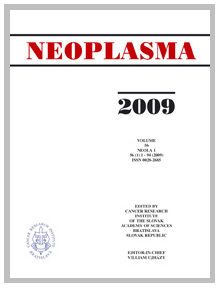Journal info
|
||
Select Journal
Journals
Bratislava Medical Journal Ekologia - Ecology Endocrine Regulations General Physiology and Biophysics Neoplasma 2025 Ahead of print 2024 2023 2022 2021 2020 2019 2018 2016 2017 2015 2014 2013 2012 2011 2010 2009 2008 2007 2006 2005 2004 2003 Acta Virologica Studia Psychologica Cardiology Letters Psychológia a patopsych. dieťaťa Kovove Materialy-Metallic Materials Slovenská hudba 2025Webshop Cart
Your Cart is currently empty.
Info: Your browser does not accept cookies. To put products into your cart and purchase them you need to enable cookies.
Neoplasma Vol.63, No.4, p.518-522,2016 |
||
| Title: DNA from microdissected tissues may be extracted and stored on microscopic slides | ||
| Author: M. KORABECNA, P. STEINER, M. JIRKOVSKA | ||
| Abstract: With regard to complex structure of tissues, laser capture microdissection represents an important step in analytical workflow streaming to proper molecular characterization of different cell types in examined samples. Therefore the simple method for simultaneous processing of higher numbers of microdissected tissues leading not only to rapid and efficient DNA isolation but allowing also the repeated sampling and easy storage may be useful in the practice of histopathological laboratories. We elaborated such a methodology applicable downstream after the microdissection from formalin-fixed paraffin embedded tissues. The tissues for examination are microdissected directly into the circular areas having the diameter 2 mm and marked on the microscopic slide. In this way, one slide is able to accommodate multiple samples. The DNA extraction is performed in low volume of buffer with Proteinase K in a droplet covered by mineral oil just on the slide. Mineral oil in the quality for molecular biology not only avoids evaporation during DNA extraction, but it helps to position the microdisssected tissue, to control the level of cell lysis microscopically and to protect the DNA sample during subsequent manipulations. We provided the evidence that DNA isolated by our methodology remains in the positions on microscopic slide for months without any changes in the lengths of available fragments and that it may be removed from each position repetitively for different kinds of analysis. The new methodological approach presented by us can be practically applied in broad spectrum of laboratories performing routinely genetic analysis on microdissected tissues. |
||
| Keywords: laser capture microdissection – FFPE tissue sections – DNA isolation –DNA storage – PCR | ||
| Published online: 14-Jul-2016 | ||
| Year: 2016, Volume: 63, Issue: 4 | Page From: 518, Page To: 522 | |
| doi:10.4149/neo_2016_404 |
||
|
|
 download file download file |
|

